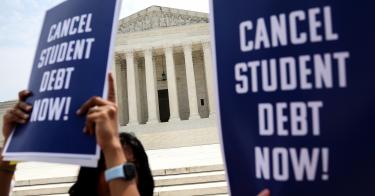Taxpayers can be grateful that the Supreme Court struck down President Joe Biden’s unconstitutional student loan bailout. The justices saved America from not just a massive expense on the current federal balance sheet, but excessive borrowing and higher tuition costs in the future.
Biden’s student loan amnesty plan was a misuse of the 2003 HEROES Act and would have put taxpayers on the hook for up to $20,000 per student loan borrower. Even those borrowers with relatively high incomes were eligible for the handout; households making $250,000 annually were eligible for up to $40,000 in “forgiveness”—a euphemism for a taxpayer bailout.
The exact cost of such a bailout would have been far higher than the White House’s estimate of $380 billion, with some estimates exceeding $1 trillion. The disparity between these estimates stems from the fact that a taxpayer-funded bailout of student loan debt would have created incentives that in turn change people’s behavior.
If the Supreme Court had gone along with Biden’s unconstitutional bailout of student loan borrowers, then future borrowers would expect some amount of “forgiveness” too. That provides an additional incentive to borrow money.
>>> Taxpayers Breathe Sigh of Relief—Temporarily—After Student Loan Decision
Imagine you’re debating buying an item with the following advertisement: “Purchase with store credit and be automatically entered into a drawing to refund your purchase price!” That’s enough to push some people off the fence and into the checkout line. The same is true with using student loans to pay for tertiary schooling.
Similarly, Biden’s student loan amnesty would have created a moral hazard, where insuring people encourages them to take more risks.
The first example of behavioral changes is that some people who would not otherwise attend college decide instead to go and borrow to finance their attendance. That would increase attendance by about 300,000 and student loan debt by about $3 billion.
Higher college attendance may sound like a good thing—after all, we want everyone to have maximum educational freedom and opportunities. But for the potential borrowers in question here, they have decided that college is not in their best interest. The marginal factor pushing them to attend college is that they believe the venture will ultimately be “free”—i.e., financed by the taxpayer.
When their debt is not forgiven, many will be unable to repay their loans. That will increase the amount of student loan debt in default by $48 billion.
But those already attending college, and the colleges themselves, are also affected by the increased incentive to borrow. The average student would borrow between $3,000 and $6,000 more. Knowing their clientele has more cash, colleges respond by increasing their cost of attendance—between $2,000 and $4,000.
>>> Student Loan Forgiveness Scheme Unlawful
That means student loan debt could increase by an extra $100 billion each year, and the aggregate cost of attendance could rise by more than $60 billion. In short, bailing out student loans today actually makes college less affordable in the future.
To be clear, these financial considerations were not part of the justices’ decision in striking down Biden’s student loan amnesty. It was judged unconstitutional for its lack of legal merit and because it violated private contracts. But we can still be very grateful for that fact that this ruling has prevented further distortions in the student loan market.
But we’re not out of the woods yet. The Biden administration is still trying to bailout student loans through other means, like changing borrowers’ choice of repayment plans. Some of those proposed plans would have a minimum payment of $0 and would eventually forgive all unpaid loans, with many borrowers never repaying any of their loans.
Let’s hope that doesn’t get implemented, since the negative effects would be the same as the unconstitutional bailout which was just struck down.
This piece originally appeared in MSN




